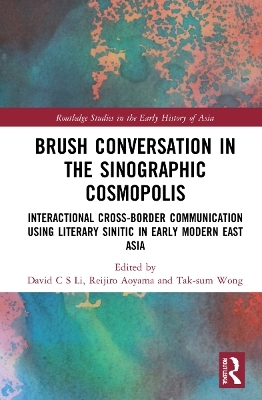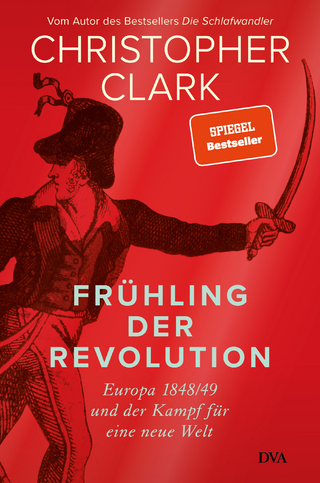
Brush Conversation in the Sinographic Cosmopolis
Routledge (Verlag)
978-0-367-49940-2 (ISBN)
For hundreds of years until the 1900s, in today’s China, Japan, North and South Korea, and Vietnam, literati of Classical Chinese or Literary Sinitic (wényán 文言) could communicate in writing interactively, despite not speaking each other’s languages.
This book outlines the historical background of, and the material conditions that led to, widespread literacy development in premodern and early modern East Asia, where reading and writing for formal purposes was conducted in Literary Sinitic. To exemplify how ‘silent conversation’ or ‘brush-assisted conversation’ is possible through writing-mediated brushed interaction, synchronously face-to-face, this book presents contextualized examples from recurrent contexts involving (i) boat drifters; (ii) traveling literati; and (iii) diplo- matic envoys. Where profound knowledge of classical canons and literary works in Sinitic was a shared attribute of the brush-talkers concerned, their brush-talk would characteristically be intertwined with poetic improvisation.
Being the first monograph in English to address this fascinating lingua-cultural practice and cross-border communication phenomenon, which was possibly sui generis in Sinographic East Asia, it will be of interest to students of not only East Asian languages and linguistics, history, international relations, and diplomacy, but also (historical) pragmatics, sociolinguistics, sociology of language, scripts and writing systems, and cultural and linguistic anthropology.
David C. S. Li (李楚成) is Professor and Head of the Department of Chinese and Bilingual Studies (中文及雙語學系),, The Hong Kong Polytechnic University (香港理工大學). He received his BA in English (Hong Kong), MA in Applied Linguistics (France), and PhD in Linguistics (Germany). He has published widely in multilingualism in Greater China, World Englishes, Hong Kong English, China English, bilingual education and language policy, bilingual interaction and code-switching (translanguaging), Cantonese as an additional language, and South Asian Hongkongers’ needs for written Chinese. He speaks Cantonese, English and Mandarin fluently, is conversant in German and French, and is learning Japanese and Korean. More recent interests focus on the historical spread of written Chinese (Sinitic) and its use as a scripta franca until the early twentieth century in Sinographic East Asia (China, Japan, Korea and Vietnam). Reijiro Aoyama’s (青山玲二郎) research is concerned with transnational and global processes mediated by migration and the movement of information, symbols, capital and cultural commodities. His research interests include anthropology of work and mobility, narratives of migration, and material and non-material culture of cross-border interactions. He has conducted several long-term ethnographies of the Japanese presence in East Asia, and has published on Japanese diaspora, craftsmanship, and emotional work in service industries, Sino-Japanese animation, and historical cross-border interactions mediated by Sinitic writing. Before taking up his post at The Hong Kong Polytechnic University, he taught at Fudan University, Tsinghua University, and City University of Hong Kong. Tak-Sum Wong (黃得森) is a post-doctoral fellow in the Department of Chinese and Bilingual Studies at the Hong Kong Polytechnic University. He received his BEng in Computer Science from Hong Kong University of Science and Technology (2004), and PhD in Linguistics from City University of Hong Kong (2018). He has built a treebank of the Tripiṭaka Koreana during his doctoral study and has been working on the quantitative study of historical syntax. His research expertise covers Chinese historical linguistics, Cantonese linguistics, corpus linguistics, computer-assisted language learning, Chinese dialectology and Chinese palæography.
Frontispiece 1
Frontispiece 2
List of Figures
List of Tables
List of Contributors
Foreword to Brush Conversation in the Sinographic Cosmopolis: the second miracle xvii
Preface
Epigraph
Map
1 Writing-mediated cross-border communication face-to-face: from Sinitic brush-talk (漢文筆談) to pen-assisted conversation
DAVID C. S. LI, REIJIRO AOYAMA AND WONG TAK-SUM
2 East Asian brush-talk literature: introduction and proposed classification
WANG YONG
PART 1
Brush-talk involving traveling literati and boat drifters in East Asia
3 Brush conversation between maritime officials and foreign seafarers in drifting records in eighteenth-and nineteenth-century East Asia
MATSUURA AKIRA AND REIJIRO AOYAMA
4 Senzaimaru’s maiden voyage to Shanghai in 1862: brush conversation between Japanese travelers and people they encountered in Qing China
DAVID C. S. LI AND REIJIRO AOYAMA
5 Identity verification and negotiation through Sinitic brush-talk in Ming China and Japan: drifting accounts by Ch’oe Pu (1488) and Yi Chi-hang (1696–1697)
HUR KYOUNG-JIN
6 A study of salient linguistic features of two Ryukyuan brush conversations in Sinitic, 1611 and 1803
WONG TAK-SUM
PART 2
Brush-talk involving diplomatic envoys in East Asia
7 Sinitic brush-talk between Vietnam and China in the eighteenth century: a study of vice-envoy Lê Quý Đôn’s mission to Qing China
NGUYỄN TUẤN-CƯỜNG AND N GUYỄN THỊ-TUYẾT
8 Lingua-cultural characteristics of brush-talk: insights from Ōkōchi Documents 大河內文書
WANG BAOPING
9 The charm and pitfalls of Sinitic brush-talk: a study of brush conversation records involving the first legation staff of Late Qing China in Japan (1870s–1880s)
LIU YUZHEN
10 Japanese-Korean brush-talk during the early Edo period, 1603–1711
KOO JEA-HYOUN AND JOO IAN
11 Brush-talk between Chosŏn envoys and Tokugawa literati: contesting cultural superiority and ‘central efflorescence’ 中華, 1711–1811
JANG JIN-YOUP
PART 3
Script-specific communication in Sinitic: significance for historical pragmatics, cultural anthropology, and East Asian studies
12 Sociocultural functions of Chinese characters and writing: transnational brush-talk encounters in mid-nineteenth- and early-twentieth- century East Asia
REIJIRO AOYAMA
13 Discussion paper
REBEKAH CLEMENTS
Index
| Erscheinungsdatum | 21.04.2022 |
|---|---|
| Reihe/Serie | Routledge Studies in the Early History of Asia |
| Zusatzinfo | 8 Tables, black and white; 13 Halftones, black and white; 13 Illustrations, black and white |
| Verlagsort | London |
| Sprache | englisch |
| Maße | 156 x 234 mm |
| Gewicht | 453 g |
| Themenwelt | Geschichte ► Allgemeine Geschichte ► Neuzeit (bis 1918) |
| Geisteswissenschaften ► Geschichte ► Regional- / Ländergeschichte | |
| Geisteswissenschaften ► Sprach- / Literaturwissenschaft ► Sprachwissenschaft | |
| ISBN-10 | 0-367-49940-1 / 0367499401 |
| ISBN-13 | 978-0-367-49940-2 / 9780367499402 |
| Zustand | Neuware |
| Haben Sie eine Frage zum Produkt? |
aus dem Bereich


